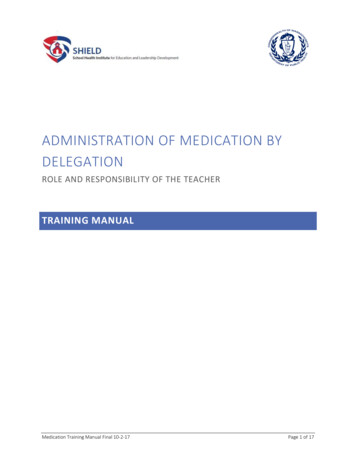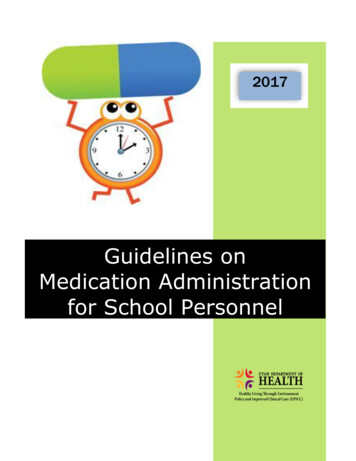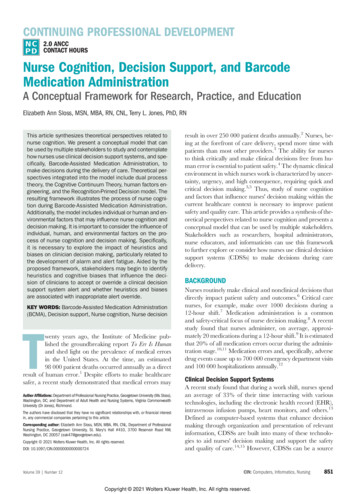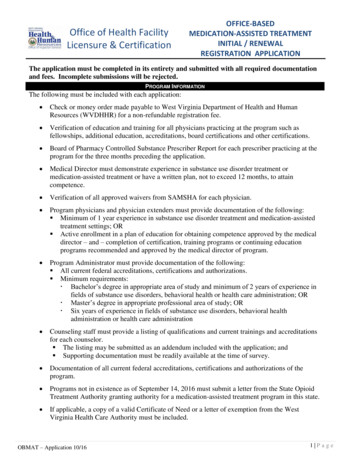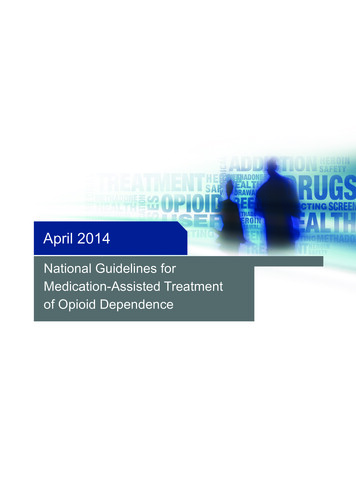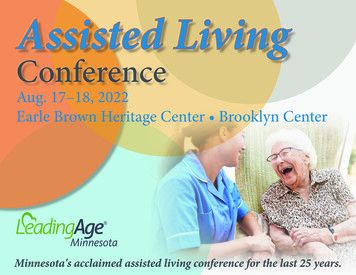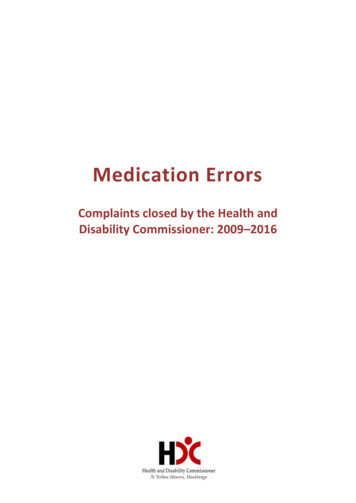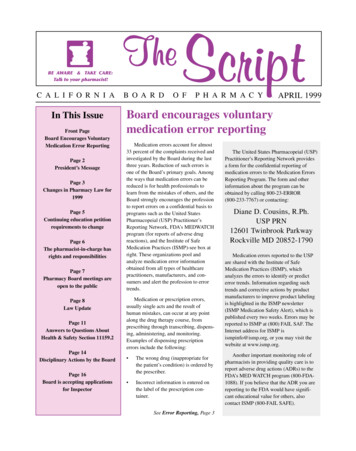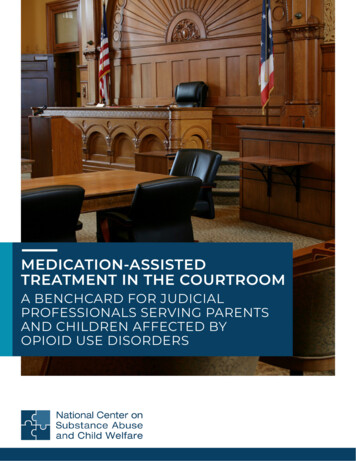
Transcription
MEDICATION-ASSISTEDTREATMENT IN THE COURTROOMA BENCHCARD FOR JUDICIALPROFESSIONALS SERVING PARENTSAND CHILDREN AFFECTED BYOPIOID USE DISORDERS
The National Center onSubstance Abuse and ChildWelfare (NCSACW) preparedthis benchcard to help courtsand their collaborativepartners improve systems andservices for families affectedby substance use disorders(SUDs). Information includedhere comes from NCSACW’syears of practice-basedexperience providing technicalassistance (TA) to states, Tribes,and communities; extensiveliterature reviews; empiricalresearch; and collaborationwith other experts in the feldsof child welfare, substance useand mental health treatment,public health, family treatmentcourts, maternal health, andpediatrics. Points of view oropinions expressed in this toolare those of the authors anddo not necessarily representthe offcial positions or policiesof the Substance Abuseand Mental Health ServicesAdministration (SAMHSA) orthe Administration on Children,Youth, and Families (ACYF).1OVERVIEW OF MEDICATIONASSISTED TREATMENT (MAT)Medication-assisted treatment (MAT) is anevidence-based treatment for opioid usedisorders (OUDs). MAT uses medications,in combination with counseling andother therapeutic techniques, to provide a“whole-patient” approach to the treatmentof SUDs.1-3 MAT is primarily used for thetreatment of addiction to opioids such asheroin; prescription pain relievers containingopiates like morphine and codeine; andsemi-synthetic opioids such as hydrocodone,oxycodone, Percocet, Vicodin, and fentanyl.SAMHSA, along with the National Instituteon Drug Abuse (NIDA), the American Societyof Addiction Medicine (ASAM), the Centersfor Disease Control and Prevention (CDC),and the American Medical Association(AMA) recommend MAT as a best practicefor treating OUDs, and the American Collegeof Obstetricians and Gynecologists (ACOG)recommends MAT as a best practice fortreating pregnant women with OUDs.Doctors have successfully prescribedbuprenorphine (Suboxone and Subutex) fornearly two decades; and methadone for morethan three decades to treat OUDs.4,5 Morerecently the Food and Drug Administration(FDA) approved oral naltrexone and extendedrelease injectable naltrexone (also known asVivitrol) as highly effective medications.Treatment of Alcohol Use Disorder (AUD): Acamprosate, disulfram (also known as Antabuse), oral naltrexone, and Vivitrol have proven effective.A BENCHCARD FOR JUDICIAL PROFESSIONALS SERVING PARENTSAND CHILDREN AFFECTED BY OPIOID USE DISORDERSMEDICATION-ASSISTED TREATMENT 01
The following specifes key details that partners should bring to court. They are designedto support, guide, educate, and ensure effective communication, coordination, andcollaboration among members of the court and community partners.INFORMATION FOR THE COURT TO INFORM COURTOVERSIGHT OF MATWho are the communityprovider(s) of methadone and/or buprenorphine?How has MAT affected theparticipant’s recovery?What is the treatmentprovider’s clinicalrecommendation for the use ofMAT?What type of counseling(frequency and duration) isprovided to accompany MAT?If MAT is not recommended,what are the reasons?What measures are prescribersusing to reduce the riskof medication misuse ordiversion?If MAT is prescribed, whatdoes the provider recommendfor medication, dose, andfrequency?If the participant is experiencingchallenges with MAT, counseling,or other aspects of their treatmentplan, what is the provider’srecommendation to the court?Are additional medication(s)prescribed for mental healthmanagement? If so, what arethe indications?Does the treatment provider orprogram address the effects ofSUD on families?A BENCHCARD FOR JUDICIAL PROFESSIONALS SERVING PARENTSAND CHILDREN AFFECTED BY OPIOID USE DISORDERSMEDICATION-ASSISTED TREATMENT 02
QUESTIONS TO ASK COURT PARTICIPANTSDid you have access to MAT this week?Which medication(s) are you prescribed?Have you informed your physician that you are taking medication for yourdisorder?Did you receive counseling this week along with your MAT?How did MAT help you maintain your sobriety this week?How has MAT helped you access other supports (housing, employment,additional services)?How has MAT helped with your parenting role and your relationship with yourchildren?Where do you plan to keep your medications at home to ensure your childrendo not have access to them? (For more recommendations, visit Medication Safety SafeKids Worldwide)How will you pay for your prescriptions once released from court?What barriers exist for you to receive MAT?How can I help you with recovery and the use of MAT?FREQUENTLY USED MEDICATIONS FOR MATThose unfamiliar with the science of MAT sometimes question why an individualis taking what is perceived as a high dose of methadone or buprenorphine. Theuse of MAT, type of medication, dosage, frequency, and duration of treatmentare inindividualizdividualizeded medicmedicalal decisions made at the sole discretion of the licensedmedical professional providing services. People may safely take medications usedin MAT for months, years, or even a lifetime. Plans ttoo stopstop anyany medicmedicationation must6,7,8alwayalwayss be discussed with a doctdoctoror.Table 1 provides examples of frequently usedMAT for OUD.A BENCHCARD FOR JUDICIAL PROFESSIONALS SERVING PARENTSAND CHILDREN AFFECTED BY OPIOID USE DISORDERSMEDICATION-ASSISTED TREATMENT 03
TABLE 1: MAT FOR OPIOID USE ZubsolvBunavailFor moreinformation,visit SAMHSA’spage onbuprenorphine.ROUTE eImplantSublocadeHOW ITWORKSGenerallyMakes thebrain thinkit is stillgetting ternatedaysFor moreinformation, visitSAMHSA’s pageon walsymptoms,and reducesthe risk ofoverdoseMakes thebrain thinkit is stillgetting theproblemopioidMethadoneMethadoseTHINGS TOCONSIDERFREQUENCYOF DOSINGPillLiquidDaily usePreventscravingsandwithdrawalsymptomsand reducesthe risk ofoverdoseTreatment can start as soon assomeone enters withdrawalRelapse risk increases if youforget, or choose not to takemedicationIn an effort to increase accessto treatment, more recentlegislature3 allows qualifiedpractitioners to dispense orprescribe buprenorphine for thetreatment of OUDs in settingsother than Opioid TreatmentPrograms (OTP), upon completionof specialized trainingTreatment can start right away; noneed for detoxificationLess flexible schedule: Dosingoccurs in the early morning; dailyclinic visits required for medicationadministrationMethadone is often a good optionfor longtime opioid users or thosewho have tried other treatmentsunsuccessfullyMay cause drowsiness beforemaintenance dose is determinedDoes not cause physicaldependenceNaltrexoneDaily useVivitrolFor moreinformation, visitSAMHSA’s pageon redevery 4weeks oronce amonthBlocks theeffectsof bothopioids andalcoholApprovedfor opioiduse disorderand alcoholuse disorderNot recommended for pregnantwomen; methadone orbuprenorphine recommended forpregnant women with OUDHigher overdose risk afternaltrexone wears off due todecreased toleranceNaltrexone may affect treatmentfor chronic pain by blockingopioid receptorsNaltrexone is not a controlledsubstance; it can be prescribed oradministered in any healthcareor SUD setting, such as a doctor’soffice or clinicAdapted from Quick Guide: MAT Use for Opioid and Alcohol Use Disorders, California Department of Health Care ServicesAddiction medications may have various side effects for each person. Information specific toside effects can be found on the U.S. Food and Drug Administration website’s medication searchengine. Each medication described by SAMHSA can be found on their page for MAT Medications,Counseling, and Related Conditions.Suboxone, Zubsolv, and Bunavail are combination medications that include buprenorphine and naloxone.The Drug Addiction Treatment Act of 2000, the Comprehensive Addition Recovery Act (CARA), and the Substance Use-Disorder Prevention OpioidRecovery and Treatment for Patients and Communities (SUPPORT) Act allow qualified practitioners to dispense or prescribe buprenorphine in settingsother than OTPs such as physician offices, significantly increasing access to treatment.23A BENCHCARD FOR JUDICIAL PROFESSIONALS SERVING PARENTSAND CHILDREN AFFECTED BY OPIOID USE DISORDERSMEDICATION-ASSISTED TREATMENT 04
RESOURCES The NCSACW is a national resource center providinginformation; expert consultation; and free training andtechnical assistance tools for child welfare, dependencycourt, and substance use treatment professionals toimprove the safety, permanency, well-being, and recoveryoutcomes for children, parents, and families. The NCSACW, together with the Offce for Civil Rights(OCR), created a training series, Explorxploriningg Civil RightsPrototecectionstions forfor IndividualsIndividuals in RecoRecovereryy frf rom an Opioid UseDisorderDisorder, to provide information to child welfare and courtprofessionals about federal disability rights protections thatapply to some parents with an opioid or other substanceuse disorder and involved in child welfare. Center for Children and Family Futures (CCFF) partneredwith the National Association of Drug Court Professionals(NADCP) to publish family treatment court resourcesincluding the Family TrTreatmeatmentent CourCourtt PlanningPlanning Guide,Transitioninansitioningg toto a FamilyFamily CentCenterereded ApproacApproach:h: BestPracacticticeses andand LessonsLessons LearLearnned frf rom ThreeThree AdulAdultt DrugCourourtsts, and the Family TrTreatmeatmentent CourCourtt Best PrPracacticticeeStanStandardardsds. SAMHSA is the agency within HHS that leads public healthefforts to advance the behavioral health of the nation.SAMHSA’s mission is to reduce the impact of substanceuse and mental illness in America. Visit the SAMHSAwebsite for more information on treatment services forSUDs, rights for individuals on MAT, federal guidelinesfor opioid treatment programs, and SAMHSA’s treatmentlocator which provides referrals to local treatment facilities,support groups, and community-based organizations—fltered by need. For more information visit SAMHSA’s FindTreatment page or call 800-662-4357 (HELP), a free andconfdential helpline open 24/7. SAMHSA’s 2021 update of Treatmeatmentent ImproImprovemementent PrPrototococolol(TIPTIP)) 63: MedicationsMedications forfor Opioid Use DisorderDisorder reviews theuse of the three FDA-approved medications used to treatOUD, and the other strategies and services needed tosupport recovery for people with OUD.A BENCHCARD FOR JUDICIAL PROFESSIONALS SERVING PARENTSAND CHILDREN AFFECTED BY OPIOID USE DISORDERSMEDICATION-ASSISTED TREATMENT 05
The National Institute on Drug Abuse (NIDA) is the leadfederal agency supporting scientifc research on drug useand its consequences. NIDA’s Prininciplesciples of Drug AddicAddictiontionTreatmeatment:ent: A ResearcResearch-Based Guide (Thir(Thirdd Edition)Edition) offersguidance and key components of effective treatmentprograms. The Child Welfare Information Gateway (CWIG) provideschild welfare and adoption professionals, as well as thegeneral public, access to information, resources, and toolscovering topics on child welfare, child abuse and neglect,out-of-home care, adoption, and more. CWIG developed the Family Engagement Inventory(FEI), a cross-disciplinary collection of informationthat helps professionals understand the nuances offamily engagement, while improving collaborationand outcomes for families across child welfare, juvenilejustice, behavioral health, education, and early childhoodeducation.REFERENCES1National Institute on Drug Abuse. (2020, July 10). Drugs and the brain. s-behavior-scienceaddiction/drugs-brain2Lander, L., Howsare, J., & Byrne, M. (2013). The impact of substance use disorders on families and children: From theory to practice. Social Work inPublic Health, 28(3-4), 194-205. ance Abuse and Mental Health Services Administration. (n.d.). Medication-assisted treatment (MAT). t4Drug Enforcement Administration, Diversion Control Division, Drug & Chemical Evaluation Section. (2019, December). Buprenorphine. https://www.deadiversion.usdoj.gov/drug chem info/buprenorphine.pdf5Institute of Medicine. 1995. The Development of Medications for the Treatment of Opiate and Cocaine Addictions: Issues for the Government and PrivateSector. Washington, DC: The National Academies Press. https://doi.org/10.17226/49066Friedman, S., & Wagner-Goldstein, K. (2016). Medication-assisted treatment in drug courts: Recommended strategies. Center for Court ment%20in%20Drug%20Courts.pdf7Geneva: World Health Organization. (2009). Guidelines for the psychosocially assisted pharmacological treatment of opioid dependence. Annex 12,prescribing guidelines. National Center for Biotechnology Information. rneys at the Legal Action Center authored, Know Your Rights: Rights for Individuals on Medication Assisted Treatment. HHS Publication No. (SMA)09-4449. Rockville, MD: Center for Substance Abuse Treatment, Substance Abuse and Mental Health Services Administration, 20099Friedman, S., & Wagner-Goldstein, K. (2016). Medication-assisted treatment in drug courts: Recommended strategies. Center for Court ment%20in%20Drug%20Courts.pdf10Sofuoglu, M., DeVito, E. E., & Carroll, K. M. (2018). Pharmacological and behavioral treatment of opioid use disorder. Psychiatric Research and ClinicalPractice, 1(1), 4–15. https://doi.org/10.1176/appi.prcp.2018000611Blue Cross Blue Shield of Massachusetts Foundation. (n.d.). Fact sheet: buprenorphine. [Fact sheet]. phine.pdf12Substance Abuse and Mental Health Services Administration. (n.d.). MAT medications, counseling, and related conditions. nt/medications-counseling-related-conditionsA BENCHCARD FOR JUDICIAL PROFESSIONALS SERVING PARENTSAND CHILDREN AFFECTED BY OPIOID USE DISORDERSMEDICATION-ASSISTED TREATMENT 06
13Substance Abuse and Mental Health Services Administration. (n.d.). Buprenorphine. norphine14Geneva: World Health Organization. (2009). Guidelines for the psychosocially assisted pharmacological treatment of opioid dependence. Annex 12,prescribing guidelines. National Center for Biotechnology Information. scribers’ Digital Reference. (n.d.). Methadone hydrochloride - drug summary. 647CONTACT USEmail NCSACW atncsacw@cffutures.orgVisit the website athttps://ncsacw.samhsa.govCall toll-free at(866) 493-2758Acknowledgement: This resource is supported by contract numberHHSS270201700001C from the Substance Abuse and Mental Health ServicesAdministration (SAMHSA), co-funded by Children’s Bureau (CB), Administration onChildren, Youth and Families (ACYF). The views, opinions, and content of this resourceare those of the authors and do not necessarily refect the views, opinions, or policiesof SAMHSA, ACYF or the U.S. Department of Health and Human Services (HHS).BENCHCARD FOR JUDICIAL PROFESSIONALS SERVING PARENTS ANDCHILDREN AFFECTED BY OPIOID USE DISORDERSMEDICATION-ASSISTED TREATMENT 07
Substance Abuse and Child Welfare (NCSACW) prepared this benchcard to help courts . in combination with counseling and other therapeutic techniques, to provide a . J., & Byrne, M. (2013). The impact of substance use disorders on families and children: From theory to practice. Social Work in Public Health, 28 (3-4), 194-205. https://doi.org .



